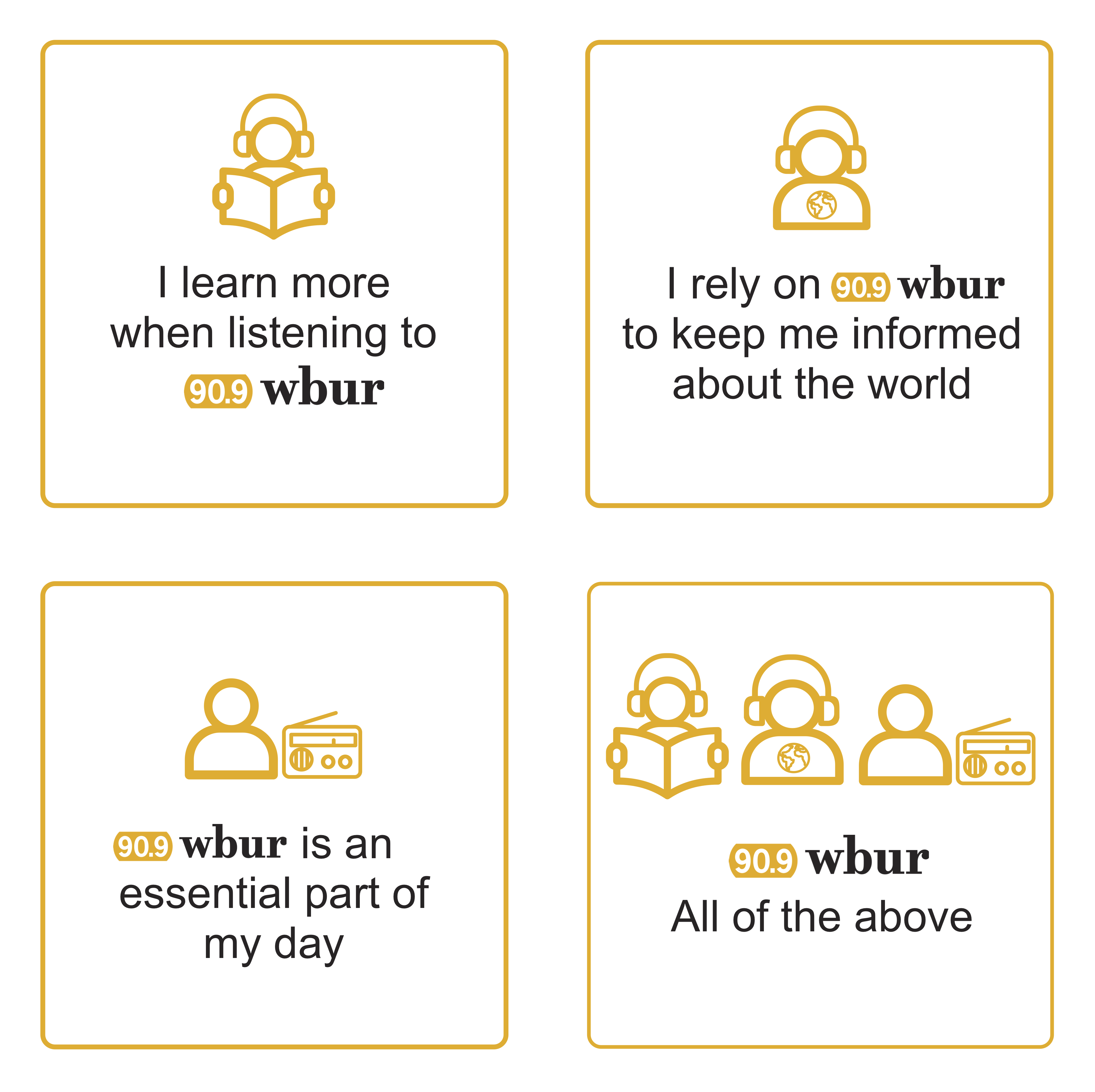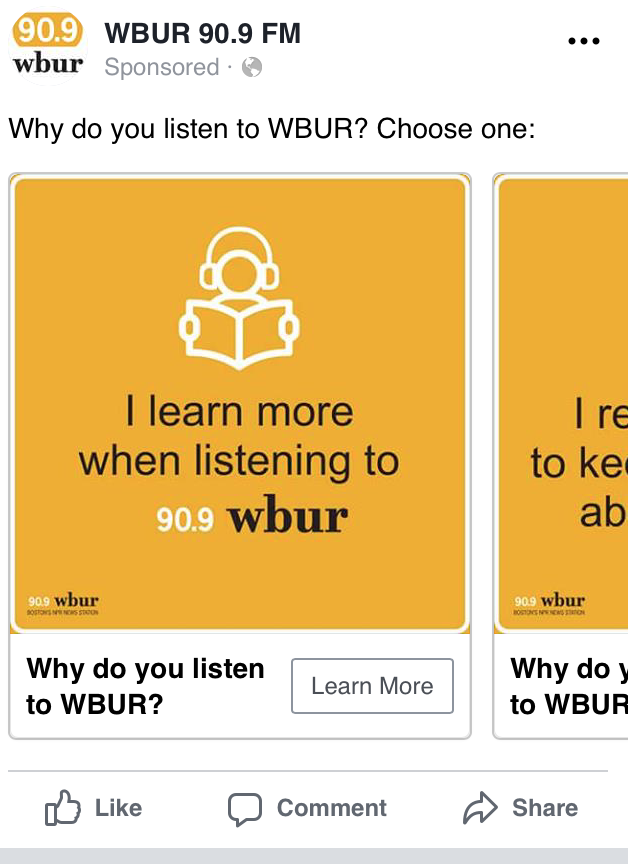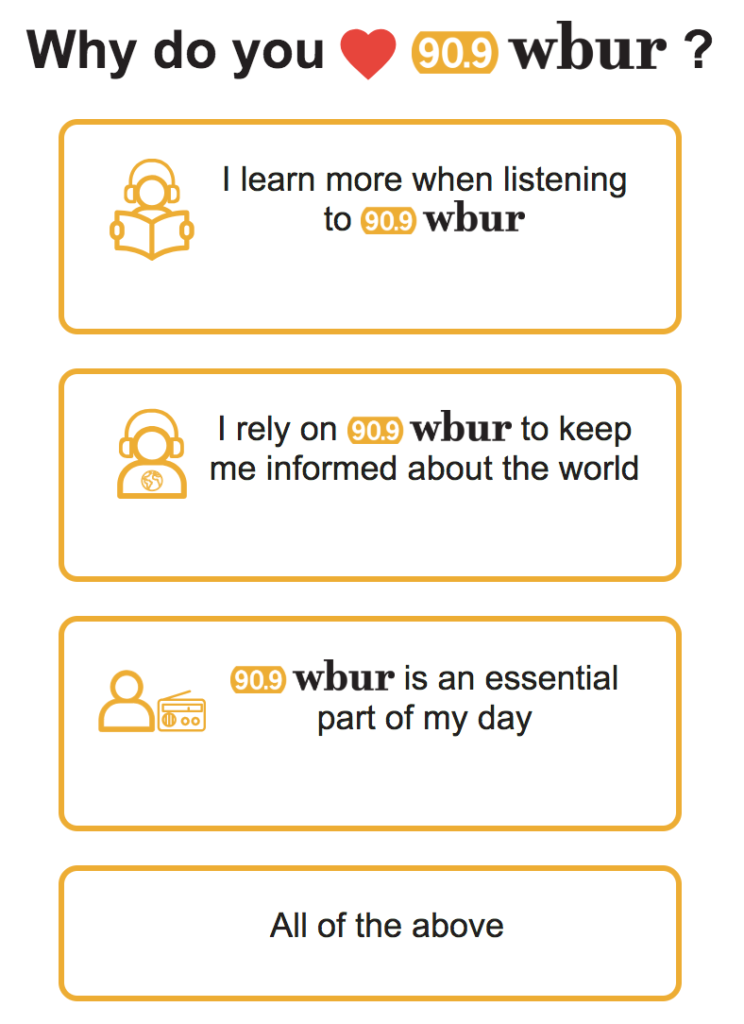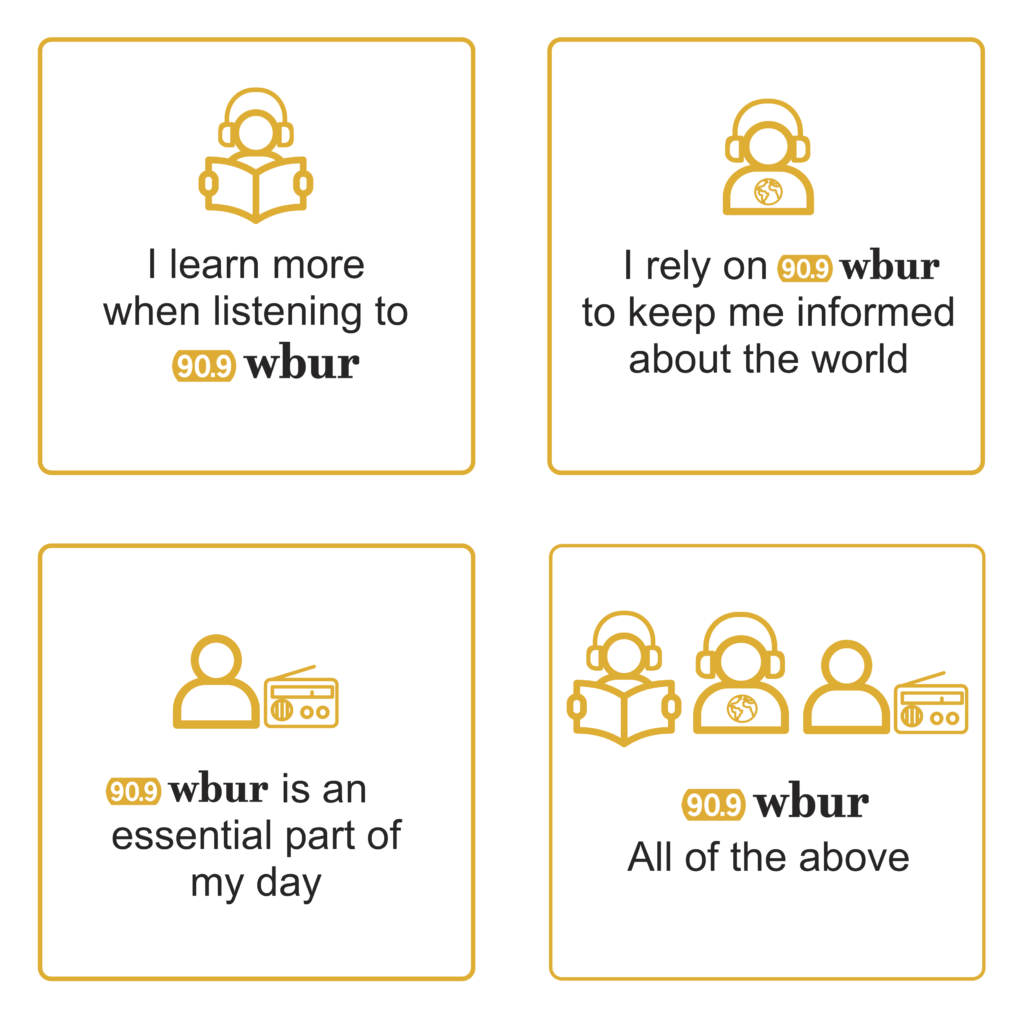[This is the 3rd blog post on BizLab Fellow Wendi Ding’s project, the Persona Experiment.]
With three personas in hand, we designed an experiment to test the effectiveness of communicating to WBUR’s audience by persona. We wanted to determine two things with an experiment: know if the personas reflect unique populations in our listener audience and understand, if we communicated to users in the language and perspective of their persona, that they will engage more with us. As a reminder, the three personas are the Aspirational Learner, the World Citizen, and the Lifelong Listener which represent why someone listens to WBUR: either to get smarter, to track the news, or to feel an emotional connection.
The structure of the experiment was to find users loyal to WBUR via Facebook Ads, ask them a question to have them self-select their persona, and then take them through a series of interactive messages explaining why they should donate. If everything worked perfectly, users who got the correct persona messaging would complete a donation.
The User Journey to Donation
WBUR’s radio programming and podcasts have a national following, but not all of these regular listeners are ready to donate — they may not know what WBUR is and they may not be emotionally committed to the programming they are listening to. So before designing specific messages to speak to the personas, we needed to articulate to ourselves the WBUR Donor Journey — the path a user takes from first listening to WBUR programming to eventually donating. The purpose in doing this is to ensure that we target our messaging to users based on where they are in the journey.
WBUR Listener Journey
- Become a listener. This is the moment when someone first encounters WBUR content, either on-air, on demand, online, or on stage. At this point, they may or may not know who created the content. A connection exists between the content and the listener, not between the program, WBUR, and the listener.
- Rely on the program. Next, as the consumer listens, reads, and/or experiences the content repeatedly, they begin to associate value with the program, and rely on the program for delivering that quality.
- Become aware of WBUR brand. For our longtime listeners and lifelong Boston residents, it is hard to remember a time before knowing WBUR (!), but this is a critical point in a donor’s journey. Listeners, in order to get to a point of donation, they must be aware of WBUR as a brand, distinct from WGBH (the “other” Boston NPR station) and from NPR. For listeners to a specific syndicated program, particularly on demand, they may not recognize WBUR’s brand until the program explains multiple times the relationship between the program and WBUR.
- Become an insider of WBUR community. When someone is loyal to a program and aware of WBUR, we consider them to be transitioning into an “insider.” Insiders view WBUR as important to them, either because it makes them smarter, it keeps them up on the news, or it speaks to them emotionally. The work required to usher someone to this insider status is not easy, and we have drawn a lot of inspiration from The Membership Puzzle and their guidance on hosting communities of practice.
- Donate. We’ve reached the summit with our user and they are ready to donate! Or are they? The moment people have an impulse to donate is influenced many factors, and we highly recommend Erez Yoeli‘s TEDx talk on how to increase altruistic moments. We also recommend reading “Why supporters pay for journalism (hint: it’s not about exclusive access),” from the Membership Puzzle.
Based on this five stage journey, we need to target and start our communication with users at Stage 3 or 4, and we will do this by targeting ads at users who have indicated on Facebook that they are fans of WBUR, WBUR programming, and NPR, and are located within Boston.
Structure of Donation Ask
To move someone from a loyal WBUR listener and a community insider to donating, we used a script that reflects research of emphasizing that an emotional message, followed by a data-centric message, is most effective. Here is the narrative flow we decided upon for our message:
- Thank listeners for listening to WBUR and emphasize that WBUR is aligned to the mission that matches the reason this person loves WBUR.
- Remind the listener of the effort and cost spent creating the programming or content they love.
- Share a data point about how important donations are to WBUR, because only 4.5% of WBUR’s funding comes from the government (via the Corporation for Public Broadcasting).
- Ask for a donation to support the mission this persona values.
Messaging per Persona
We distilled each persona down into a statement about loving WBUR and then used that phrase to get users to self-select into one of our personas. Because Aspirational Learners are focused on content and learning, they would agree with “I learn more when listening to WBUR.” Because World Citizens are focused on the news around the world, they would align with the statement, “I rely on WBUR to keep me informed about the world.” And our Lifelong Listeners, who think of WBUR as a daily companion, would agree with “WBUR is an essential part of my day.”
So the flow our experiment first had users answer a question about why they love WBUR, and then from that moment forward they would see a message aligned to their values:
The exact text of each message is in the table below, with the green text highlighting where the text differed for each persona.
| Script for the Aspirational Learner |
Script for the World Citizen |
Script for the Lifelong Listener |
|
| 1: State our mission | A key part of our mission is to educate listeners with fresh and informative content. | A key part of our mission is to get you the latest and most important news of the day. | A key part of our mission is to provide you compelling programming, 24 hours a day. |
| 2: Remind them of our work | It takes WBUR over 50 staff hours to produce one hour of WBUR. | It takes WBUR over 50 staff hours to produce one hour of WBUR. | It takes WBUR over 50 staff hours to produce one hour of WBUR. |
| 3: Share a data point about funding | Only the first 2 minutes of each day are covered by government funding. | Only the first 2 minutes of each day are covered by government funding. | Only the first 2 minutes of each day are covered by government funding. |
| 4: Explain the impact of a donation | $75 supports 1 additional minute providing in-depth learning for all our listeners! | $75 supports 1 additional minute providing real-time updates for all our listeners! | $75 supports 1 additional minute providing daily discussion with all our listeners! |
Recruiting Experience
To recruit listeners into this experience, we used Facebook ads to identify fans of WBUR and NPR within the Boston area. We created a 4 card carousel Facebook ad (see below). The first three have the three sentences and a persona icon to represent the reason for listening to WBUR, the final card had the label “All of the above.” We offered “All of the above” to find out how much our personas overlap. If everyone chooses “All of the above”, we will learn that our personas do not represent unique reasons for listening to WBUR.
User Experience
The core messaging experience is presented in a custom, mobile-friendly web page. It is designed as a scrolling one-page site so we can can control the experiment conditions by pointing users to different pages and track engagement by tracking scroll depth and button clicks. We used Google’s suite of analytics tools, including Optimize, for splitting experimental conditions and tracking.
Using Optimize and Facebook’s built-in A/B testing, we randomized the messaging a person received, so 80% of people got the message aligned to their persona and 20% of the people saw a message aligned to an incorrect persona. If someone selected “all of the above,” they had a 33.3% chance of seeing each message.
Below are miniature screenshots of each persona’s experience. You can also check out the experience yourself with our prototype: Why do you love WBUR?
| Visual Design for Aspirational Learner |
Visual Design for World Citizen |
Visual Design for Lifelong Listener |
 |
 |
 |
The four panels were instrumented with scroll checkpoints so we could measure engagement down the page. The page finished with two buttons, “Support” and “I’ve supported before.” We expected most users would not click donate, and the option to click “I’ve supported before” was designed to help us understand why someone wasn’t donating. The donate button went to our donation page and the “I’ve supported before” page forwarded to a Thank you page.
The findings from the experiment are in our next post.



